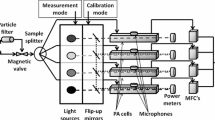Abstract
The actinic flux is the only radiometric quantity suitable for photolysisfrequency determination. It is derived from solar spectral irradiancemeasurements performed by a portable spectroradiometer in the 300–850nm wavelength range. The spectral irradiance is first divided into a directpart and a diffuse part, according to the atmospheric conditions, and thenconverted into the corresponding actinic flux quantity. As an intermediary,the ratio \(r_{dd} \) of diffuse actinic flux to diffuseirradiance is calculated by the spherical harmonics radiative code withrespect to wavelength, solar zenith angle, surface albedo, and aerosolproperties.The results of extensive sensitivity studies of \(r_{dd} \) asa function of the main atmospheric parameters are discussed and lead to theconclusion that aerosol optical depth is the major critical value for aprecise \(r_{dd} \) determination. The global algorithm totransform spectral irradiance into actinic flux is finally applied forphotodissociation rate calculations by convolution of the obtained actinicflux spectra with the absorption cross-sections and quantum yields of themolecule studied. Photolysis rates of different atmospheric photooxidants havebeen measured with this spectroradiometric method during the summers of 1993and 1994 in Brittany and in Portugal. The ozone and nitrogen dioxidephotodissociation rates obtained present a good agreement with thej(O3) and j(NO2) actinometerresults, for the same experimental conditions in Brittany.
Similar content being viewed by others
References
Bird, R. E., 1984: Simple solar spectral model for direct and diffuse irradiance, Solar Energy 23, 528–530.
Bird, R. E. and Riordan, C., 1986: Simple solar spectral model for direct and diffuse irradiance on horizontal and tilted planes at the Earth’s surface for cloudless atmospheres, J. Climate. Appl. Meteorol. 25, 87–97.
Bittar, A. and McKenzie, R. L., 1990: Spectral ultraviolet intensity, measurements at 45°S: 1980 and 1988, J. Geophys. Res. 95, 5597–5603.
Bruehl, C. and Crutzen, P. J., 1989: On the disproportionate role of tropospheric ozone as a filter against solar UV-B radiation, Geophys. Res. Lett. 16, 703–706.
Cachorro, V. E., Gonzales, M. J., and de Frutos, A. M., 1993: Analysis of the relationships between Junge size distribution and Angström turbidity parameters from spectral measurements of atmospheric aerosol extinction, Atmos. Environ. 27, 1585–1591.
Chang, J. S., Brost, R. A., Isaksen, S. A., Madronich, S., Midelton, P., Stockwell, W. R., and Walcek, C. J., 1987: A three dimensional eulerian and deposition model: Physical concepts and formulation, J. Geophys. Res. 92, 14681–700.
Cotte, H., Carlier, P., Shetter, R. E., Cantrell, C. A., and Devaux, C., 1996: A spectroradiometric method for the determination of the photodissociation rate of NO2, O3 and other atmospheric molecules, Atmos. Environ.special issue, submitted.
Cotte, H., 1995: Thesis report, University of Paris VII, obtained 30th October 1995, Chapter III, part concerning the optical fiber receptor to measure actinic flux.
Davison, B., 1958: Neutron Transport Theory, University Press, Oxford.
Demerjian, K. L., Schere, K. L., and Peterson, J. T., 1980: Theoretical estimation of actinic flux and photolytic rate constants of atmospheric species in the lower atmosphere, Adv. Environ. Sci. Technol. 10, 369–459.
Deschamps, P. Y., Fouquart, Y., Tanré, D., Herman, M., and Lenoble, J., 1994: Study of the effects of scattering on the monitoring of atmospheric constituents, European Space Agency Report.
Devaux, Claude, Thèse de Doctorat en Sciences Physiques, 1977: Contribution à l’étude de la couverture nuageuse de Vénus par l’analyse des mesures photométriques et des profils de flux solaires transmis, Laboratoire d’Optique Atmosphérique de Lille.
Feister, U., 1994: Measurements of chemically and biologically effective radiation reaching the ground, J. Atmos. Chem. 19, 289–315.
Finlayson-Pitts, B. J., Pitts, J. N., 1986: Atmospheric Chemistry: Fundamentals and Experimental Techniques, Wiley-Interscience, New York.
Gerber, H. E., Hindmann, E. E., 1982: Light Absorption by Aerosol Particles, Spectrum Press, Hampton, Virginia.
Gueymard, C., 1993: Development and performance assessment of a clearly sky spectral radiation model, Solar 93, 22nd ASAS Conf., Washington DC.
Junkermann, W., Platt, U., Volz, T. A., 1989: A photoelectric detector for the measurement of photolysis frequencies of ozone and other atmospheric molecules, J. Atmos. Chem. 8, 203–227.
Lenoble, J., 1993: Atmospheric radiative transfer, Deepack Publishing, Hampton-Virginia.
Lorente, J., Redano, A., De Cabo, X., 1994: Influence of urban aerosol on spectral solar irradiance, J. Appl. Meteorol. 33, 406–415.
Madronich, S., 1987: Intercomparison of NO2 photodissociation and UV radiometer measurements, Atmos. Environ. 21, 569–578.
Müller, M., Kraus, A., Hofzumahaus, A., 1995: O3 to O(1D) photolysis frequencies determined from spectroradiometer measurements of solar actinic UV radiation: comparison with chemical actinometer measurements, Geophys. Res. Lett. 22, 679–682.
Ruggaber, A., Forkel, R., Dlugi, R., 1993: Spectral actinic flux and its ratio to spectral irradiance by radiative transfer model, J. Geophys. Res. 98, 1151–1162.
Ruiz Suarez, J. C., Gay, C., Castro, T., Montero, M., 1993: Photolytic rates of NO2, O3 and HCHO in the atmosphere of Mexico, Atmos. Environ. 27, 427–430.
Shetter, R. E., MacDaniel, A. H., Cantrell, C. A., Madronich, S., Calvert, J. G., 1992: Actinometer and Eppley radiometer measurements of the NO2 photolysis rate coefficient during MLOPEX, J. Geophys. Res. 97, 10349–10360.
Van Der Hage, J. C. H., Boot, W., Van Drop, H., Duykerke, P. G., Vilà Guerau de Arellano, J., 1994: A photoelectric detector suspended under a ballon for actinic flux measurements, J. Atmos. Chem. 11, 674–680.
Van Der Hage, J. C. H., 1992: Interpretation of field measurements made with a portable albedometer, J. Atmos. Oceanic Technol. 9, 420–428.
Van Weele, M. and Duynkerke, Peter, G., 1993: Effect of clouds on the photodissociation of NO2: observations and modelling, J. Atmos. Chem. 16, 231–255.
Author information
Authors and Affiliations
Rights and permissions
About this article
Cite this article
COTTE, H., DEVAUX, C. & CARLIER, P. Transformation of Irradiance Measurements into Spectral Actinic Flux for Photolysis Rates Determination. Journal of Atmospheric Chemistry 26, 1–28 (1997). https://doi.org/10.1023/A:1005763127365
Issue Date:
DOI: https://doi.org/10.1023/A:1005763127365




